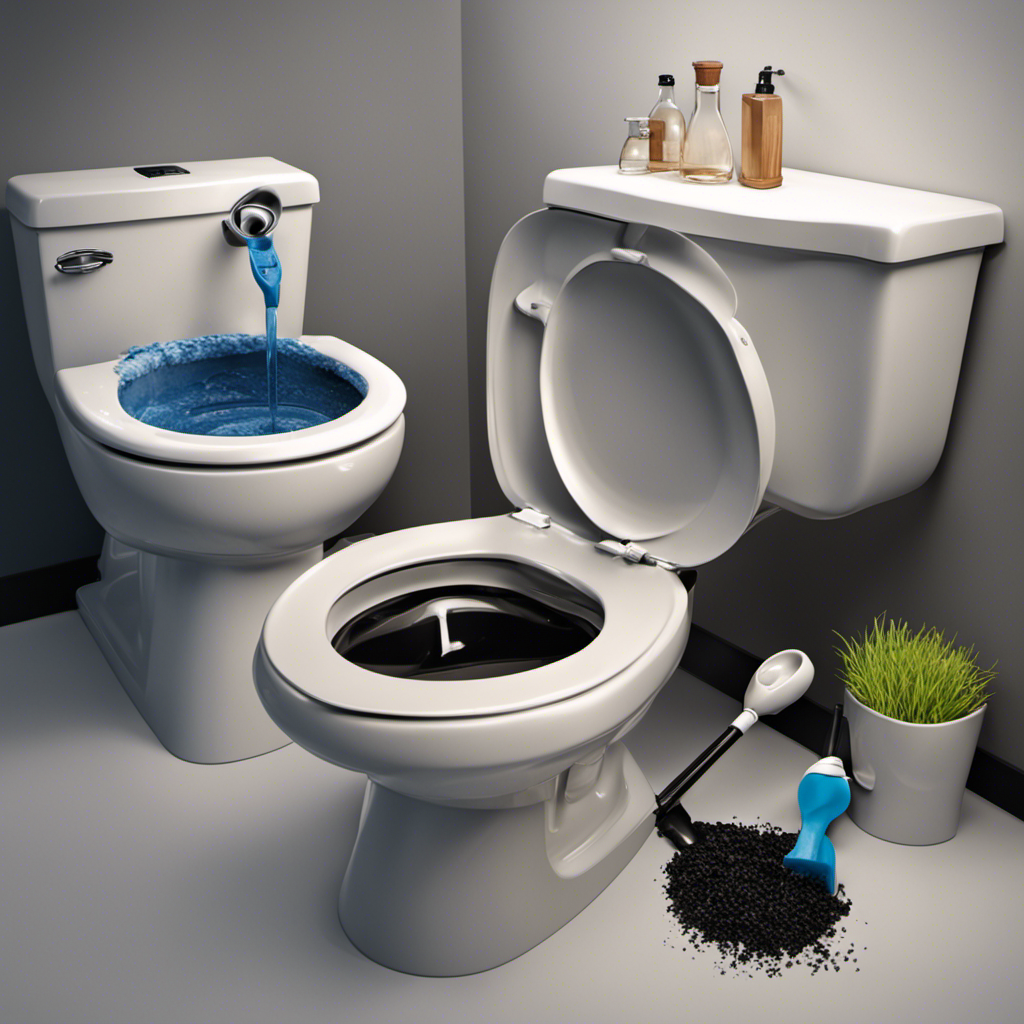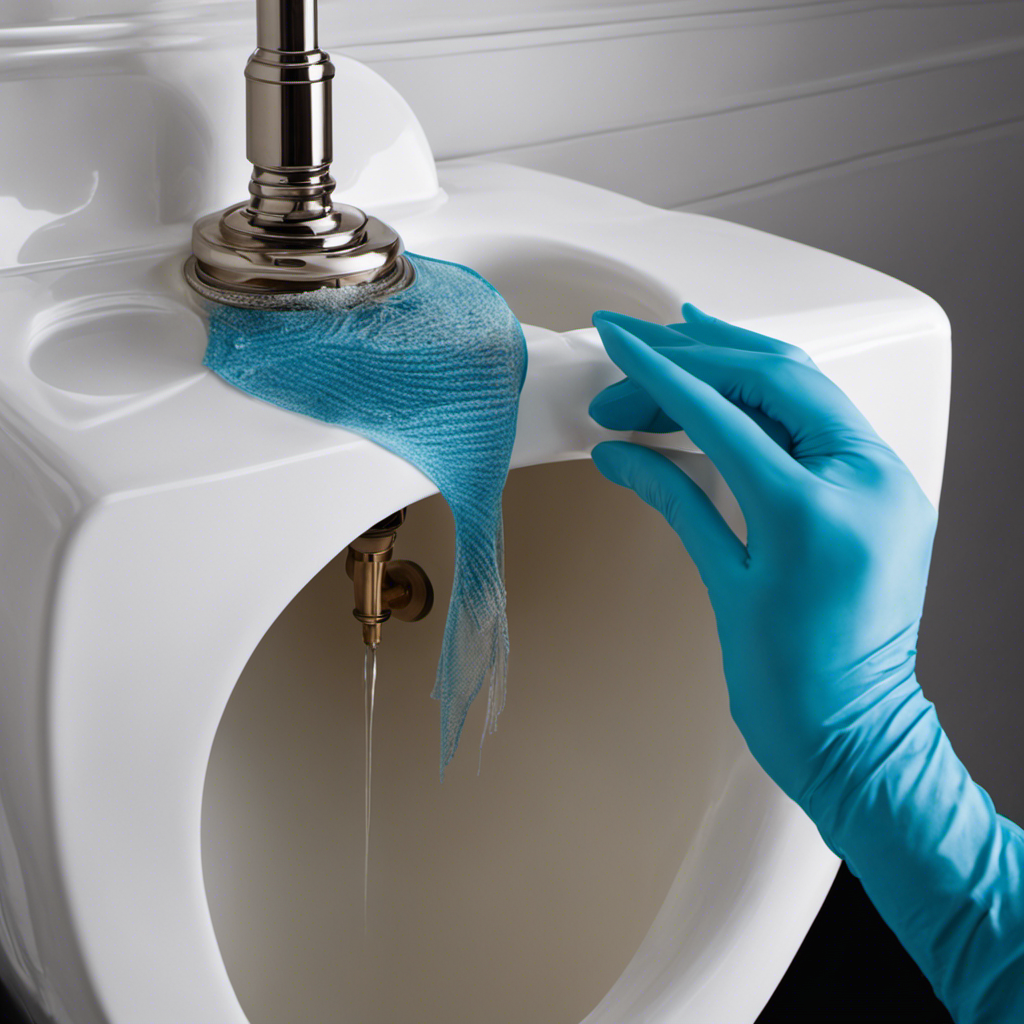I’ve had my fair share of toilet troubles, but one issue that always leaves me feeling helpless is a cracked toilet tank. That’s why I’m here to share my knowledge and expertise on how to repair it.
In this article, I’ll guide you through the step-by-step process of assessing the damage, gathering the necessary materials, draining the tank, applying the repair solution, reinforcing the cracked area, and testing the repaired toilet tank.
With my detailed instructions, you’ll have your toilet tank looking good as new in no time.
Key Takeaways
- Assess the severity of the crack and determine the appropriate repair method.
- Choose a repair kit designed for fixing cracks in porcelain or ceramic and follow the instructions carefully.
- Drain the toilet tank completely before applying the repair solution.
- Reinforce the cracked area with fiberglass cloth or mesh and epoxy resin for long-term durability.
Assessing the Damage
Before you can begin repairing the cracked toilet tank, you’ll need to assess the extent of the damage. Assessing the severity of the crack is crucial to determine the appropriate repair method.
Start by examining the crack closely and measuring its length and width. Small, hairline cracks may only require a simple patch, while larger cracks may need more extensive repairs or even a complete replacement of the tank.
Next, it’s important to determine the cause of the crack. Common causes include age, improper installation, or excessive pressure. Understanding the cause will help prevent future cracks and ensure a long-lasting repair.
Once you have assessed the severity and determined the cause of the crack, you can move forward with the appropriate repair solution.
Gathering the Necessary Materials
To begin, you’ll need to gather all the materials you’ll need.
When it comes to repairing a cracked toilet tank, choosing the right repair solution is crucial. You’ll need a repair kit specifically designed for fixing cracks in porcelain or ceramic. These kits usually include epoxy or adhesive that can bond the cracked surfaces together, creating a strong and watertight seal.
Additionally, you may need sandpaper to smooth out any rough edges and ensure a proper fit. It’s important to follow the instructions provided with the repair kit carefully to ensure a successful repair.
If you’re not confident in your DIY abilities or if the crack is severe, it’s advisable to seek professional help. A plumber or a bathroom repair specialist will have the expertise and experience to handle the repair effectively and ensure the longevity of your toilet tank.
Draining the Toilet Tank
Once you’ve gathered all the necessary materials, you can start draining the toilet tank.
Draining the toilet tank is an important step in toilet tank maintenance as it allows you to work on the cracked area without water getting in the way.
To begin, turn off the water supply valve located near the bottom of the toilet tank.
Flush the toilet to remove as much water as possible.
Next, use a sponge or towel to soak up any remaining water in the tank. Be thorough in this step to prevent further damage.
Once the tank is completely drained, you can proceed with applying the repair solution to fix the crack and restore the integrity of the tank.
Applying the Repair Solution
Make sure you’ve completely drained the toilet tank before applying the repair solution to fix the crack.
When it comes to repairing a cracked toilet tank, there are several effective repair techniques you can use. However, it’s important to avoid common mistakes that can further damage the tank or compromise its integrity.
Here are some key points to keep in mind:
- Use a high-quality epoxy resin or putty specifically designed for toilet tank repairs.
- Clean and dry the cracked area thoroughly before applying the repair solution.
- Apply the solution evenly and generously, making sure to cover the entire crack.
- Allow the repair solution to cure completely before refilling the tank and using the toilet again.
Reinforcing the Cracked Area
When it comes to reinforcing a cracked area in a toilet tank, there are several techniques that I’ve found to be the most effective.
One of the best options is to use fiberglass cloth or mesh, which provides a strong and durable reinforcement.
Additionally, applying epoxy resin or a waterproof sealant can help to further strengthen the cracked area.
These techniques not only provide immediate reinforcement but also offer long-term durability, ensuring that the repaired toilet tank will last for years to come.
Best Reinforcement Techniques
To reinforce a cracked toilet tank, you should consider using epoxy or fiberglass patch kits. These techniques are effective in repairing cracks and preventing future damage. Here are four reasons why they are the best reinforcement options:
- Epoxy and fiberglass patch kits provide a strong and durable bond, ensuring long-lasting repairs.
- They are easy to use, making it convenient for anyone to fix their cracked toilet tank without the need for professional help.
- These materials are resistant to water and chemicals, preventing further deterioration and leaks.
- By reinforcing the cracked area with epoxy or fiberglass patches, you can avoid costly replacements and save money in the long run.
Using these techniques not only restores the structural integrity of your toilet tank but also gives you peace of mind, knowing that your repairs will withstand the test of time.
Long-Term Durability Options
Now that we’ve discussed the best reinforcement techniques for repairing cracked toilet tanks, let’s move on to the next step: ensuring long-term durability.
It’s important to not only fix the cracks but also prevent future damage from occurring. One option to achieve this is by using epoxy resin. This strong adhesive can be applied to the cracks, creating a durable seal and reinforcing the weakened areas.
Additionally, you can consider using a toilet tank liner. These liners are designed to cover the entire inner surface of the tank, providing an extra layer of protection against cracks and leaks.
Regular maintenance is also crucial in preventing future damage. This includes checking for any signs of cracks or leaks, tightening loose fittings, and avoiding excessive force when handling the tank.
Testing the Repaired Toilet Tank
After repairing the cracked toilet tank, you should test it by filling it with water and checking for any leaks or drips. Testing the repaired seal is crucial to ensure that your repair work was successful.
Here’s how you can evaluate the water pressure and effectiveness of the repaired seal:
-
Visual Inspection: Carefully examine the tank and surrounding areas for any signs of water leakage or drips. Look for water pooling on the floor or wet spots on the toilet tank.
-
Listen for Sounds: Pay attention to any unusual sounds such as hissing or dripping that could indicate a faulty seal.
-
Check Water Level: Fill the tank to the recommended water level and observe if it remains stable or drops. A dropping water level might suggest a leak.
-
Flush Test: Flush the toilet and observe if the water flows smoothly without any leaks or sudden drops in water pressure.
Conclusion
In conclusion, repairing a cracked toilet tank may seem like a daunting task, but it can be easily accomplished with the right materials and steps.
By assessing the damage, gathering the necessary materials, draining the toilet tank, applying the repair solution, and reinforcing the cracked area, you can restore your toilet tank to its former glory.
Once the repair is complete, it’s time for the ultimate test. As you flush the toilet and see the water flow effortlessly, you’ll feel a sense of satisfaction and accomplishment.










